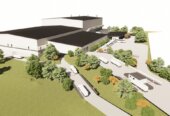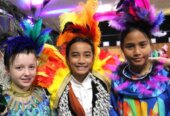
Ōtorohanga Kiwi House general manager Jo Russell at the start site of the new development.
Building is well underway on the multi-million-dollar redevelopment of the Ōtorohanga Kiwi House, one that will future-proof the 50-year-old facility and sustainably enhance its conservation efforts.
The project will take place over the next three years. Kiwi House manager Jo Russell says it will transform the park, boost the local economy through using local skills, and set the facility up once borders re-open to recoup the Covid-19 losses resulting from the dearth of international tourists.
“Ninety-five percent of our income comes from international tourism – that stopped overnight last year and hasn’t come back,” she said.
Co-founded by local pharmacist Barry Rowe and bricklayer Bob Horsfall, the Kiwi House opened in 1971 with a three-pronged approach – as a sanctuary for native birds and reptiles, as a breeding centre undertaking scientific research and reintroducing species to the wild, and as a tourist attraction with educational opportunities. Nocturnal enclosures, ponds and aviaries were built, numerous different species were introduced and the kiwi captive breeding programme, done collaboratively with the Department of Conservation (DOC), specialist groups and a network of volunteers, has drawn wide acclaim.
The first Kiwi chick hatched a couple of years later and there have been hundreds more since, many of them repatriated into native bush areas. The Kiwi House has even featured in a BBC documentary narrated by Kiwi actor Sam Neill.
“It has been a fantastic effort over the years – innovative and massively successful,” said Jo, who became manager in 2015 after starting as education officer in 2001. Conservation has been a lifetime passion, and while direct human contact is minimised, Jo gets very attached to individual birds watched through hidden cameras.
“They have such different personalities, it is such a privilege to watch them. Some of our foundation females are still here … one has produced over 60 offspring and another has produced eggs well into her 40s.”
The facility is run by the Ōtorohanga Kiwi House Charitable Trust. The decision to go ahead with a major development was made because it was felt that while the kiwi viewing experience was one of the best in the country, the rest of the park was outdated and ill-suited to groups of visitors.
Stage one of the project is humming along, incorporating the redevelopment of the service area, a new Mahoenui Giant Weta breed-for-release centre, a small hospital facility, two holding aviaries and a water storage area. Stage two will include walk-through areas for kaka, blue duck and insect habitats, and stage three, the construction of brown teal and wetland habitats. Stage four will see the Kiwi Night Zone extended, and stage five, the construction of a wildlife diet preparation facility and an incubation and hatchery facility. A new visitor centre and administration area will form part of stage six.
A commitment is in place for $5 million of the initially $8 million project, a figure initially pegged in 2017. A loan of $2 million has come from the Ōtorohanga District Council, a further $2 million from the Infrastructure Reference Group (part of the government’s ‘shovel-ready development programme), with another $1 million from the Ōtorohanga Charitable Trust.
Building it ‘green’ to a high level of sustainability is key, Jo said, as is the decision to incorporate stories and activities related to local iwi.

Jo outside one of the nocturnal kiwi facilities.
Community involvement has always been strong, as was exhibited during last year’s lockdown when locals contributed thousands of dollars of food as the house struggled against Covid-19 restrictions. The same generosity has been offered this time around, but in 2021, the Kiwi House is better prepared.
“On the back of last year, we changed the way we access our food requirements. For example, we used to get thousands of insects couriered to us, but we’ve now developed our own massive insect colony,” she said. “Our long-term vision is to be a sustainable business operation that will attract around 120,000 visitors a year.”









